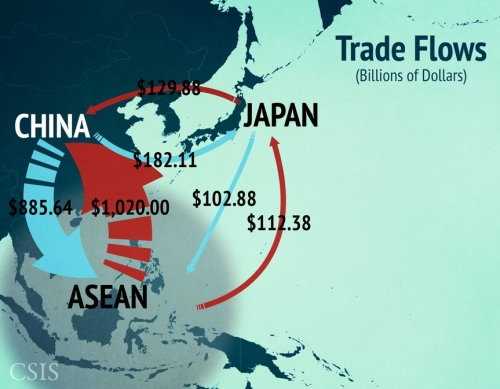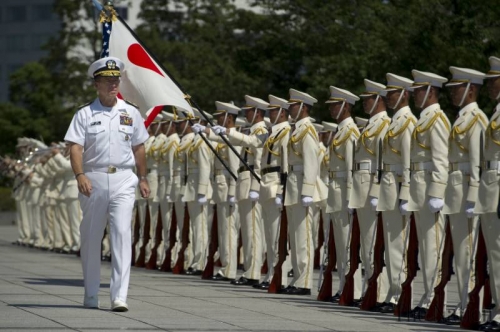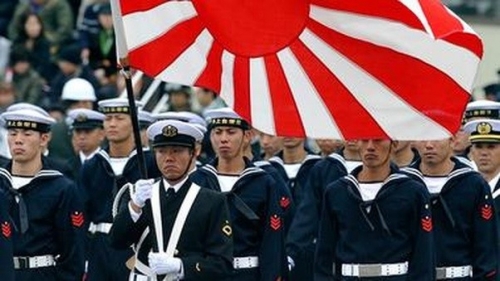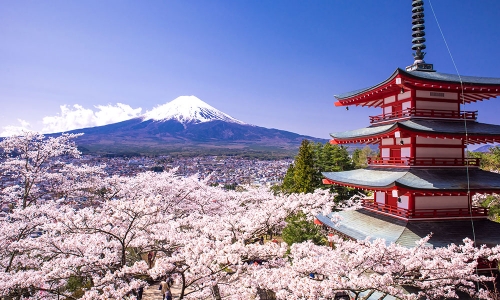vendredi, 17 novembre 2017
21st-Century Geopolitics Of Japan
Japan, as the Asian geographic analogue of Great Britain, is a strategic outlier in the Eurasian supercontinent by virtue of its location, which has in turn greatly influenced its political decisions across the centuries and shaped it into an historically thalassocratic power. The Oriental state prudently chose to implement selective Westernization following the Meiji Restoration in 1868, which allowed it to grow by leaps and bounds ahead of its regional competitors and ultimately emerge as a Great Power in its own right. Japan’s grand strategy was to literally become the Great Britain of Asia, and to that end it sought to carve out its own empire in the Eastern Hemisphere through brutal conquest and a divide-and-rule strategy which would ultimately enable it to replace its European counterparts as the uncontested hegemon in this part of the world.
The World War II-era “Greater East Asian Co-Prosperity Sphere” was the high point of Japan’s “traditional” geostrategic ambitions, after which it was humiliatingly occupied by the US until the present day following the two devastating nuclear bombings in Hiroshima and Nagasaki. From 1945 onwards, Tokyo has been Washington’s “Lead From Behind” partner in East and Southeast Asia, being encouraged by the US to take on a leading regional role in order to give America a “local face” behind which it could project its dominance. It’s for this reason why the US appointed Japan to become the main player in the Asian Development Bank (ADB) and actively supported its efforts to invest in the former territories that had briefly constituted its imperial realm during the Second World War.
The end of the Cold War and subsequent rise of China as a Global Power (inadvertently aided and abetted by US investments) saw Japan’s role progressively transform from a solely economic-institutional “Lead From Behind” capacity to a military one, with Tokyo only just recently “reinterpreting” its post-war constitution in order to allow the deployment of military troops abroad and sale of military equipment to foreign partners. For all intents and purposes, the US is tacitly encouraging Japan to “more peacefully” follow in its pre-World War II-era footsteps in reasserting its traditional Rimland ambitions in East and Southeast Asia, though for as much as this might lead one to believe that Tokyo is still acting as a total puppet of Washington, its leadership has surprisingly begun a fast-moving rapprochement with Moscow.
This seemingly inexplicable turn of events is but one of the many paradigm shifts taking place all across the globe and in every single sphere as the Multipolar World Order gradually enters into being, and the consequences of this comprehensive change are expected to impact on the grand strategies of each Great Power, Japan included. It’s therefore of heightened relevancy to examine the 21st-century geopolitics of the country, though taking care to note that all future developments concerning this state are much more dependent on domestic trends than they are for most other players. That being the case, the analysis will begin by examining how Japan’s domestic situation influences its foreign policy, after which it will then elaborate more on the external manifestations of Tokyo’s grand strategy. The final part of the research will then summarize the prevailing trends that one can expect from Japan’s 21st-century geostrategy.

Demographic Die-Out
Japan’s population is dying out, and fast. The number of senior citizens is surging, while child births are way below replacement level. To make matters worse, Japanese young adults are eschewing sex for a variety of socio-cultural reasons, mostly thought to have something to do with the typically stressful life of urban workers and the convenience that the near-ubiquity of technology provides in “satisfying” carnal desires and creating the easily manageable illusion of a “relationship”. If the present trends continue, then Japan is expected to suffer one of the most profound population losses ever for a peacetime population in the coming decades, which has led to many observers becoming extraordinarily concerned about the country’s overall future. Considering Japan’s global importance as the world’s third-largest economy, this could be expected to have major implications for all of its partners, both fellow Great Powers and developing states alike.
Robotic Replacements
There is, however, a chance that no dire scenarios will unfold so long as Japan is successful in replacing its shrinking population with robots. It may sound futuristic but it’s already happening, at least when it comes to the economy. “This Company’s Robots Are Making Everything—and Reshaping the World”, a very insightful article published by Bloomberg in mid-October 2017, provides an eye-opening look at just how important the Japanese robotics company Fanuc has been in making this happen. It’s by and far the world leader in this field, having already captured a quarter of the global market. In addition, nearly one-third of all the world’s industrial robotics orders last year were Fanuc sales to China, which interestingly tightens the complex economic interdependency between these two rivals and shows just how important of a driver this company is for the global economy at large. Accordingly, it’s only natural then that Fanuc takes the lead in replacing Japan’s dwindling human workforce with robots in the future, since it’s already replacing the labor force of other countries as it is.
So long as there’s a stable and inversely proportional relationship between the decrease in Japan’s population and the rise of its industrial robotic sector, then theoretically speaking, there isn’t much for Tokyo to worry about on the structural level. Instead of fretting about what to do with its newfound unemployed masses like the rest of the world is doing, Japan could just work on retraining its citizens to fill the crucial non-robotic niches that are still left in its economy. It remains likely that the world will nevertheless eventually employ some combination of “universal basic income” (UBI) and virtual reality (VR) to placate the population along the lines of the long-term scenario forecast in the author’s work about “The Geopolitics Of The Techno-Civilizational World Order”, but Japan will probably have the least difficulty in doing this because of the “natural” rate at which the country is transitioning to it anyhow.

Without any undemocratic subversive behavior on the part of the Japanese elites, their country is already moving towards the dystopian outcomes associated with “Agenda 21”, but with the key difference being that Japan will experience minimal social disruption so long as its food and energy needs continue to remain provided for. The first of course deals with feeding the remaining human population, which shouldn’t be too troublesome if their numbers continue to diminish and technological advances in industrial-scale urban agriculture continue. As for the latter, no robotic-driven civilization-society can function without reliable energy supplies, and it’s here where many believe that Japan will forever remain dependent on geopolitical processes beyond its control in the Mideast, though the reality of the matter is that Tokyo has sought to preemptively avoid this crippling vulnerability through alternative energy advancements and a game-changing rapprochement with Moscow.
The Russian Rapprochement
The geopolitical dimension of Japan’s energy policy has seen it rapidly improve relations with Russia, which were stagnant for decades because of the US-manufactured issue that Tokyo refers to as the “Kuril Islands Dispute”. The contours of this conundrum are outside the scope of this analysis, but it’s relevant to say that it took Japan’s flexibility on the issue to rejuvenate ties with Russia, which are currently on the rise and better than at any time in the post-war period. Russia is receptive to Japan’s outreaches because it needs investment in its resource-rich but underpopulated Far East, and likewise, Japan needs reliable access to these said resources, be they agricultural, mineral, or especially energy. Altogether, the dynamics of the Russian-Japanese partnership represent a dual balancing act for both parties that was described at length in the author’s 2016 work about how “Russia’s Diplomatic Balancing Act In Asia Is To The Benefit Of Its Chinese Ally”, with the obvious caveat being that Tokyo isn’t doing this to aid Beijing even if that’s indeed the inadvertent outcome of what’s happening.
Carrying on, Russia is seen as a reserve of immense energy wealth which could easily power Japan’s future robotic society for decades to come, and without any of the attendant geostrategic risks that come from importing resources from the conflict-prone Mideast across the bottlenecked Strait of Malacca and then through the contentious waters of the South China Sea. Russia is therefore conceptualized as Japan’s neighboring “battery”, though one which will only share its power provided that Tokyo concedes to accept Moscow’s sovereignty over the Kuril Islands, albeit possibly through the unique NISEC sub-state socio-economic sharing arrangement that the author suggested last year. On a larger level, the Japanese-Russian rapprochement is geostrategically advantageous for Tokyo because it gives the island nation a bit more maneuverability for negotiating with the US, and it also sends a signal to China that Japan is interested in an apolitical non-hostile presence along its northeastern continental borderland. This plays into the prestige that Japan is trying to cultivate as it reestablishes itself as a Great Power and attempts to lessen the complete strategic dependence that it’s historically had on the US since the post-war military occupation.
The Race For Resources
Russia can be very useful for powering Japan’s energy-intensive robotic society in the future, but these automated replacement workers won’t do anything for the country’s economy unless they have raw materials to work with in producing items for export. The Russian Far East can only provide some of what’s needed, and definitely not on the scale that the Japanese economy requires, which is why Tokyo has had to scour the world for the necessary resources. This has seen the country establish a post-war economic presence in Southeast Asia with the encouragement of the US, as well as engaging in sizeable investments all across Africa after the end of the Cold War. The parallel rise of China during this latter period meant that the world’s most populous country was now competing for the same number of finite physical resources, therefore turning this relaxed search mission into a pressing race against Japan’s historic rival.

Trade Route And Transit State Tango
Prospecting resources and developing new marketplaces is one thing, but accessing them is another, and that’s why the world is presently in the midst of an intense period of competitive connectivity. China’s One Belt One Road global vision of New Silk Road connectivity is slated to transform the declining unipolar global system into an emerging Multipolar World Order, and Tokyo is simply unable to compete with Beijing because of the disparity in scale between their two economies. It’s for this reason why Japan decided to partner with India in pioneering the so-called “Asia-Africa Growth Corridor”, also known as the “Freedom Corridor”, in order to collectively pool their existing resources and economic complementarities in carving out a niche for themselves in the Greater Indian Ocean Region. The specific geopolitics of the wider Chinese-Indian New Cold War that this is a part of were examined in detail in the author’s book-length article series on the topic for the Islamabad-based political consultancy firm CommandEleven, but it’s enough for the casual reader to understand that there’s a complex tango going on between Japan and China for access to trade routes and transit states.
The partnership with India obviously allows Japan to strengthen its presence in the Indian Ocean, while the one with Russia interestingly provides Tokyo with the chance to become the East Asian “gatekeeper” along the Northern Sea Route to Europe. Altogether, Japan’s strategic cooperation with these two Great Powers is predicated on the self-interested idea of securing its access to crucial trade routes and transit states, though this also in and of itself gives Tokyo influence over regions that are strategically important for Beijing as well. The ideal outcome would be that these two East Asian powerhouses join forces in strengthening Silk Road Globalization through a combination of active cooperation and friendly competition with one another institutionalized through Japan’s prospective membership in the Chinese-led Asian Infrastructure Investment Bank and the possible establishment of the megaregional Free Trade Area of the Asia-Pacific (FTAAP) and Regional Comprehensive Economic Partnership (RCEP) economic deals. Heavy US influence on Japan will probably preempt this from happening, however, and therefore lead to Tokyo continuing to function as one of the key pillars in the “China Containment Coalition” that’s being built all across the Indo-Pacific.
The antagonistic scenario that the US is pushing Japan towards with China is the same as what it’s doing vis-à-vis the EU and Russia, though in a different manner accommodating for the changed situational relations between them. Instead of deceptively emphasizing a “zero-sum” outcome when it comes to competitive connectivity projects and the race for resources, the US is promoting a “zero-sum” mentality in relation to “values”, having spared no expense or effort to convince the EU elites that Russian “values” are purportedly incomparable with Western ones and therefore constitute a “threat”. The whole point of this massive disinformation operation on both ends of Eurasia is to prevent the ultimate Great Power convergence between the EU and Russia on the Western half and China and Japan on the Eastern one, which would collectively result in most of the supercontinent being liberated of unipolar influence when accounting for the multipolar impact of Russia’s “Ummah Pivot” in the “Greater Mideast” and China’s Silk Road success in ASEAN. India is of course the geostrategic exception in this model, but it would likely be forced to fall into line with the Multipolar World Order in this scenario or otherwise risk hemispheric isolation as the US’ last main outpost.
The Intricacies Of The Japanese-Chinese Competition
Accepting that the current trends indicate that the US-provoked Japanese-Chinese competition will probably extend into the indefinite future, the most responsible thing that can be done is to examine the intricacies of this New Cold War rivalry from a thought-provoking perspective uncommon to most analyses on this topic. Instead of focusing on the advantages that China has in this rivalry like a lot of analysts have already done, it’s worthwhile exploring the topic from the reserve angle in looking at it from Japan’s perspective in order to identify what possible advantages Tokyo might have as well. For instance, the Japanese “Maritime Self-Defense Force” already functions as a blue-water navy even if it does so unofficially, and there’s a chance that it could give China a serious run for its money in any potential clash between the two. Added to that is Japan’s robotic prowess, which could lead to pivotal military advances in the future that might decisively shift the balance of power between the two.
That said, the above factors are only applicable when it comes to military affairs, but the likelihood of a hot conflict between the two isn’t too probable for a variety of reasons, partly having to do with the complex economic interdependence between them but also the US’ mutual defense obligations to Japan. Both parties are vulnerable to Hybrid War disruptions in the shared transit states constituting their respective competitive connectivity projects in mainland ASEAN (the “Greater Mekong Subregion”), the Mideast and Central Asia, and East Africa, but China will always be more at risk than Japan because of how much it depends on these routes in order to secure its own domestic stability. The inverse proportional relationship between Japan’s declining population and rising robotic replacements means that Tokyo could theoretically weather any transit state disruptions much better than China, which has staked its entire 21st-century future on the New Silk Roads in order to sustain domestic growth and prevent the socio-political unrest that would inevitably accompany any Hybrid War-inflicted economic downturn.

Veiled Vulnerabilities
Despite its salient strategic advantage in being comparatively (key word) less dependent on transit state volatility than China, Japan isn’t exactly in a position to directly press its advantage against its rival if times got tough for Beijing. Neither side can afford a trade war against the other, which in any case would be more devastating for Japan than for China because of the monopoly that the People’s Republic enjoys on rare earth mineral production. Japan needs these resources in order to sustain its technological-robotic future, so it’s not in a position to tempt China to cut off its exports like it temporarily did in 2010 in connection with a flare-up of the East China Sea dispute. Nor, for that matter, could Japan afford for Chinese cobalt and coltan companies in the Congo to decline selling this necessary component for electric vehicle batteries, cruise missiles, and almost every ubiquitous modern-day technological gadget such as smartphones. After all, China controls roughly 60% of the global cobalt market, the demand of which is expected to spike by two-thirds in the next decade, and securing reliable access to this indispensable resource is a pressing priority for Japan.
Another veiled vulnerability affecting Japan’s 21st-century geostrategy is closer to home in the form of the Ryukyu Islands, of which anti-American Okinawa is a part. This island chain only became part of Japan relatively recently in the late 19th century, and the population of its most militarily important island resents the American bases there which are responsible for insufferable noise and a spree of high-profile crimes include rapes and murders. The locals don’t want the US to remain in their homeland, but are powerless to evict them due to the overriding influence that Washington has over Tokyo and the near-impossibility of this ever happening. Nevertheless, an asymmetrical measure that China could in theory employ (key conditional, as there isn’t any existing proof of this) would be to encourage the anti-American protest movement and help it develop to the level of an autonomous, “federalist”, or even separatist one despite the improbable odds of it actually succeeding. The point, though, would just be to cause maximum disruption at one of Japan’s most sensitive military locations in the hopes of provoking an escalating spiral of violence that could partially distract Tokyo from whatever hostile proxy action it would be engaged in against China at the time (e.g. trade war).
Prevailing Trends
All told, there are several prevailing trends that are forecast to guide Japan’s 21st-century geostrategy. In the order that they were introduced in this analysis, these are:
* Japan’s demographic die-out and replacement with robotic workers;
* The Russian-Japanese rapprochement to secure reliable energy supplies for Tokyo’s continued technological-robotic rise;
* The race for finite manufacturing resources in the “Global South” regions of mainland ASEAN (the “Greater Mekong Region”), South Asia, and East Africa, as well as the need to develop Japanese-friendly markets in this part of the world and the Mideast-Central Asia;
* The resultant competition with China for the aforesaid, and the disruptive role of American influence in turning Tokyo into Beijing’s chief Asian rival instead of its natural strategic partner in jointly advancing Silk Road Globalization in the Multipolar World Order;
* Japan’s advantageous geostrategic position in being comparatively less affected by future American-managed Hybrid Wars in the Greater Indian Ocean Region;
* and Tokyo’s veiled vulnerabilities in being dependent on China’s export of rare earth minerals to power its technological-robotic industries and the risk that Beijing could clandestinely destabilize the Ryukyu Islands through various degrees of pro-autonomy movements all the way up to separatism.

Concluding Thoughts
The simplified points mentioned above demonstrate the phased logic that goes into Japan’s grand strategy and explain some of its more recent moves, whether the surprising decision to enter into a rapprochement with Russia or the somewhat overdue one to partner up with India in the Greater Indian Ocean Region. Everything ultimately comes down to Japan’s seemingly inevitable transition into becoming the world’s first large-scale techno-robotic civilization, however, as it’s from this core trend that all the others are derived to some degree or another. Altogether, the bigger picture behind Japan’s 21st-century geostrategy should allow one to get an idea about the structural limitations inherent to its “China Containment Coalition” actions, as there’s only so much that Tokyo can do and so far that it can go against Beijing before it begins to feel the consequences from the People’s Republic discretely suspending the sale of rare earth minerals to the island nation and/or supporting a destabilizing Ryukyu autonomy campaign.
The already existing and multidimensional system of complex economic interdependency, coupled with both sides’ near-equal naval capabilities, acts as a form of checks and balances between the two Asian Great Powers and could ideally be reframed in such a way as to convince Japan’s decision makers and strategists of the mutually disadvantageous nature of the Chinese-Japanese rivalry that their American military occupier encouraged them to aggravate over the past couple of years. A reconceptualization of the relationship between these two related civilization-states could inject fresh thinking into this dynamic and demonstrate how beneficial the win-win possibilities of bilateral Silk Road cooperation are in comparison to the lose-lose “zero-sum” game that the US is provoking between them. The US wants to continue using Japan as its “unsinkable aircraft carrier” in perpetuity so that it can “contain China”, but reversely, the failure of this policy would “unchain China” by accelerating the global trend towards a Multipolar World Order.
As it stands, there aren’t any indications that Japan desires to redirect its grand strategy away from “zero-sum” unipolarity and towards win-win multipolarity, however it nonetheless can’t be ignored that Tokyo is indeed behaving in a relatively independent fashion by continuing to restore its relations with Moscow. Washington obviously isn’t too happy about this, though at the same time, the pragmatic strategists in the US’ permanent military, intelligence, and diplomatic bureaucracies (“deep state”) understand the necessity of this move and appreciate how its optics could be manipulated by savvy propagandists in an attempt to instigate suspicion between Moscow and Beijing, capitalizing on the fact that Russia hasn’t publicly explained its grand strategic balancing act. Looking forward, it’s expected that the Chinese-Japanese competition will continue all along the Greater Indian Ocean Region, merging with the Chinese-Indian one of which it’s now inextricably a part, in order to add critical mass to the Asian component of the New Cold War.
DISCLAIMER: The author writes for this publication in a private capacity which is unrepresentative of anyone or any organization except for his own personal views. Nothing written by the author should ever be conflated with the editorial views or official positions of any other media outlet or institution.
18:27 Publié dans Actualité, Géopolitique | Lien permanent | Commentaires (0) | Tags : actualité, géopolitique, politique internationale, japon, asie, affaires asiatiques, océan pacifique |  |
|  del.icio.us |
del.icio.us |  |
|  Digg |
Digg | ![]() Facebook
Facebook




Les commentaires sont fermés.